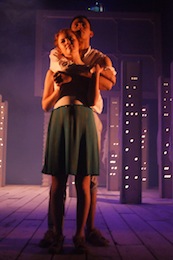For Philip Ridley couples are not so much at sea when they are apart as they are stranded on a desert island unable to ever escape one another. Such is the driving metaphor in Tender Napalm, Ridley’s imaginative exploration of love, where we are presented with a nameless man and woman who are bent on destroying each other and yet cannot conceive of life without each other.
The piece delights in its play with theatrical form: instead of the classic rise and fall of character or the resolution of a well-made plot, we are instead offered a collection of marvellous stories, fragmentary sensations, and associative images. We as an audience are marooned on the desert island of these two lovers’ psyches. Every action on stage is narrated by the characters who speak themselves into existence. Dramatic tension is created not by direct confrontation by the characters but in their conflicting narratives. In his quest to dominate the woman, the man attempts to explode her with a grenade, stabs a giant sea serpent to death, and manages to vaporise an alien planet in a spaceship. While the woman proclaims herself Queen of the island, leads an army of monkeys against the man, attempts to explode him with a grenade and recognises herself as a sea nymph related to the slaughtered sea snake.
 Their stories clash, penetrate and weave around each other in a psychotic dance where death and love embrace and dissolve. Silence always threatens to overwhelm them, to end their competing and dependent storylines. With its use of archetypal imagery (other stories include dying fathers, absent mothers, lost children and unicorns) and the repeated recourse to ancient myth and fairytale, Ridley’s script is enough to make any psychoanalyst swoon. It is of course also enough to make great theatre, if the production can match the creativity of the script in its staging. Thankfully, Sugarglass Theatre Company in this production proved to be up to the task.
Their stories clash, penetrate and weave around each other in a psychotic dance where death and love embrace and dissolve. Silence always threatens to overwhelm them, to end their competing and dependent storylines. With its use of archetypal imagery (other stories include dying fathers, absent mothers, lost children and unicorns) and the repeated recourse to ancient myth and fairytale, Ridley’s script is enough to make any psychoanalyst swoon. It is of course also enough to make great theatre, if the production can match the creativity of the script in its staging. Thankfully, Sugarglass Theatre Company in this production proved to be up to the task.
Colm McNally’s set consisted of an expansive wooden floor with numerous large skinny wooden light boxes placed on stage like trees in a fairytale forest. This set worked well at evoking the different landscapes of the twisting narratives – particularly when the lights within the boxes shone alone on the darkened stage to evoke the stars of outer space, a shimmering world under the sea and the romantic glow of a garden party where the young lovers first meet. Director Marc Atkinson made good use of McNally’s set. He has his actors move in and out of these wooden structures that act as physical barriers to them onstage whilst also representing the psychological barriers the characters create and overcome in the stories they tell.
With such a text-heavy play a difficult balance must be struck between the delivery of the language and of movement onstage. Atkinson displays great sensitivity to the different tones and tempos of the piece through his intelligent staging that never overwhelms the language with too much movement or lets the verbose language deaden the action. The lighting design (Marc Atkinson again) helped to create the extreme changes in mood of the different tales. Thus we were often plunged into darkness where the characters used torches to create an intimate atmosphere, and then we were subjected to stark lights that evoked the pain of exposure.
The success of the director in his staging was of course helped by the amazing energy and remarkable maturity of performance from the two young actors at his disposal: Aaron Heffernan playing the Man and Erica Murray as the Woman. Heffernan oozed young machismo, using his strong body to great effect in the scenes where he is required to act the superhero but then equally manages to present himself as vulnerable, shy and sensitive when required. His movements (and he moves a lot) were always deft while his delivery of the lines was consistently clear and nuanced. Erica Murray matched Heffernan’s energy and she likewise delivered the lines while skillfully moving about the stage.
The youth of the actors despite all its verve unfortunately did jar at times with Ridley’s writing. It seemed too much of a leap to imagine them as being life-weary, cynical and as parents. The costuming of the two actors by Issy D’Arcy Clark and Liadain Kaminski Ní Bhraonáin in loose fitting white and beige clothes, which hinted at the shipwrecked state of the characters, complemented the lighting, set design and staging.
This production overall showed great clarity of vision married with strong performances and has boldly announced the ambition and promise of this exciting new company.
Ian R. Walsh is a lecturer in Drama at University College Dublin and has recently published his first book Experimental Irish Theatre, After W. B Yeats